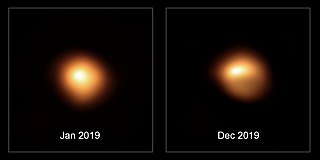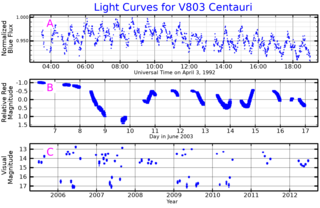Related Research Articles

A variable star is a star whose brightness as seen from Earth changes with time. This variation may be caused by a change in emitted light or by something partly blocking the light, so variable stars are classified as either:

In astronomy, cataclysmic variable stars (CVs) are stars which irregularly increase in brightness by a large factor, then drop back down to a quiescent state. They were initially called novae, since ones with an outburst brightness visible to the naked eye and an invisible quiescent brightness appeared as new stars in the sky.

An Interacting binary star is a type of binary star in which one or both of the component stars has filled or exceeded its Roche lobe. When this happens, material from one star will flow towards the other star. If the accretor is a compact star, an accretion disk may form. The physical conditions in such a system can be complex and highly variable, and they are common sources of cataclysmic outbursts.

An RS Canum Venaticorum variable is a type of variable star. The variable type consists of close binary stars having active chromospheres which can cause large stellar spots. These spots are believed to cause variations in their observed luminosity. Systems can exhibit variations on timescales of years due to variation in the spot surface coverage fraction, as well as periodic variations which are, in general, close to the orbital period of the binary system. Some systems exhibit variations in luminosity due to their being eclipsing binaries. Typical brightness fluctuation is around 0.2 magnitudes. They take their name from the star RS Canum Venaticorum.

In astronomy, a polar is a highly magnetic type of cataclysmic variable (CV) binary star system, originally known as an AM Herculis star after the prototype member AM Herculis. Like other CVs, polars contain two stars: an accreting white dwarf (WD), and a low-mass donor star which is transferring mass to the WD as a result of the WD's gravitational pull, overflowing its Roche lobe. Polars are distinguished from other CVs by the presence of a very strong magnetic field in the WD. Typical magnetic field strengths of polar systems are 10 million to 80 million gauss. The WD in the polar AN Ursae Majoris has the strongest known magnetic field among cataclysmic variables, with a field strength of 230 million gauss.

A dwarf nova, or U Geminorum variable, is one of several types of cataclysmic variable star, consisting of a close binary star system in which one of the components is a white dwarf that accretes matter from its companion. Dwarf novae are dimmer and repeat more frequently than "classical" novae.

A symbiotic binary is a type of binary star system, often simply called a symbiotic star. They usually contain a white dwarf with a companion red giant. The cool giant star loses material via Roche lobe overflow or through its stellar wind, which flows onto the hot compact star, usually via an accretion disk.
AM Canum Venaticorum is a hydrogen-deficient cataclysmic variable binary star in the constellation of Canes Venatici. It is the type star of its class of variables, the AM Canum Venaticorum stars. The system consists of a white dwarf gaining matter via an accretion disk from a semi-degenerate or white dwarf companion.
A luminous supersoft X-ray source is an astronomical source that emits only low energy X-rays. Soft X-rays have energies in the 0.09 to 2.5 keV range, whereas hard X-rays are in the 1–20 keV range. SSSs emit few or no photons with energies above 1 keV, and most have effective temperature below 100 eV. This means that the radiation they emit is highly ionizing and is readily absorbed by the interstellar medium. Most SSSs within our own galaxy are hidden by interstellar absorption in the galactic disk. They are readily evident in external galaxies, with ~10 found in the Magellanic Clouds and at least 15 seen in M31.

V803 Centauri is a cataclysmic binary consisting of a dwarf helium star losing mass to a white dwarf. It is an example of the AM Canum Venaticorum type of cataclysmic variable stars.

CE Gruis is a faint binary star system in the constellation Grus. It is a variable star, with a B-band brightness that ranges from a peak magnitude of 17.4 down to a minimum of 19.5 over a period of 108.6 minutes. The system is composed of a white dwarf and donor star, locked into a close, synchronous orbit. In such systems, known as polars, material from the donor star does not form an accretion disc around the white dwarf because of its intense magnetic field, but rather streams directly onto it along columns.
SW Sextantis variable stars are a kind of cataclysmic variable star; they are double-star systems in which there is mass transfer from a red dwarf to a white dwarf forming a stable accretion disc around the latter. Unlike other non-magnetic cataclysmic variables, the emission lines from hydrogen and helium are not doubled, except briefly near phase 0.5.

In astronomy, a superhump is a periodic brightness variation in a cataclysmic variable star system, with a period within a few percent of the orbital period of the system.

A hydrogen-deficient star is a type of star that has little or no hydrogen in its atmosphere. Hydrogen deficiency is unusual in a star, as hydrogen is typically the most common element in a stellar atmosphere. Despite being rare, there are a variety of star types that display a hydrogen deficiency.

V455 Andromedae is a dwarf nova in the constellation Andromeda. It has a typical apparent visual magnitude of 16.5, but reached a magnitude of 8.5 during the only observed outburst.

RS Canum Venaticorum is a binary star system in the northern constellation of Canes Venatici. It serves as the prototype to the class of RS Canum Venaticorum variables. The peak apparent visual magnitude of this system is below the level needed to observe it with the naked eye. It is located at a distance of approximately 443 light years from the Sun based on parallax, but is drifting closer with a net radial velocity of −14 km/s. Olin J. Eggen (1991) included this system as a member of the IC 2391 supercluster, but it was later excluded.

GP Comae Berenices, abbreviated to GP Com and also known as G 61-29, is a star system composed of a white dwarf orbited by a planetary mass object, likely the highly eroded core of another white dwarf star. The white dwarf is slowly accreting material from its satellite at a rate of (3.5±0.5)×10−11 M☉/year and was proven to be a low-activity AM CVn star. The star system is showing signs of a high abundance of ionized nitrogen from the accretion disk around the primary.

SZ Piscium is a suspected triple star system in the equatorial constellation of Pisces. The inner pair form a double-lined spectroscopic binary with an orbital period of 3.966 days. It is a detached Algol-type eclipsing binary of the RS Canum Venaticorum class with a subgiant component. The system is too faint to be readily visible to the naked eye with a combined apparent visual magnitude of 7.18. It is located at a distance of approximately 306 light years based on parallax measurements.

OY Arae, also known as Nova Arae 1910, is a nova in the constellation Ara. It was discovered by Williamina Fleming on a Harvard Observatory photographic plate taken on April 4, 1910. At that time it had a magnitude of 6.0, making it faintly visible to the naked eye under ideal observing conditions. Examination of earlier plates showed that before the outburst it was a magnitude 17.5 object, and by March 19, 1910, it had reached magnitude 12.

CR Boötis is an interacting binary system in the northern constellation of Boötes, abbreviated CR Boo. It is one of the best-known AM Canum Venaticorum stars. The system varies widely in brightness, ranging in apparent visual magnitude from 13.6 down to 17.5. The distance to this system is approximately 1,150 light years from the Sun, based on parallax measurements.
References
- 1 2 3 4 5 6 7 8 9 Solheim, J.-E. (2010). "AM CVn Stars: Status and Challenges". Publications of the Astronomical Society of the Pacific. 122 (896): 1133–1163. Bibcode:2010PASP..122.1133S. doi: 10.1086/656680 .
- 1 2 3 4 5 6 Nelemans, G. (August 2005). "AM CVn stars". In Hameury, J.-M.; Lasota, J.-P. (eds.). The Astrophysics of Cataclysmic Variables and Related Objects, Proceedings of ASP Conference. Vol. 330. San Francisco: Astronomical Society of the Pacific. p. 27. arXiv: astro-ph/0409676 . Bibcode:2005ASPC..330...27N. ISBN 1-58381-193-1.
- ↑ Patterson, Joseph; Fried, Robert E.; Rea, Robert; Kemp, Jonathan; Espaillat, Catherine; Skillman, David R.; Harvey, David A.; o’Donoghue, Darragh; McCormick, Jennie; Velthuis, Fred; Walker, Stan; Retter, Alon; Lipkin, Yiftah; Butterworth, Neil; McGee, Paddy; Cook, Lewis M. (2002). "Superhumps in Cataclysmic Binaries. XXI. HP Librae (=EC 15330−1403)". Publications of the Astronomical Society of the Pacific. 114 (791): 65. Bibcode:2002PASP..114...65P. doi: 10.1086/339450 .
- 1 2 Anderson, Scott F.; Haggard, Daryl; Homer, Lee; Joshi, Nikhil R.; Margon, Bruce; Silvestri, Nicole M.; Szkody, Paula; Wolfe, Michael A.; Agol, Eric; Becker, Andrew C.; Henden, Arne; Hall, Patrick B.; Knapp, Gillian R.; Richmond, Michael W.; Schneider, Donald P.; Stinson, Gregory; Barentine, J. C.; Brewington, Howard J.; Brinkmann, J.; Harvanek, Michael; Kleinman, S. J.; Krzesinski, Jurek; Long, Dan; Neilsen, Jr., Eric H.; Nitta, Atsuko; Snedden, Stephanie A. (2005). "Ultracompact AM Canum Venaticorum Binaries from the Sloan Digital Sky Survey: Three Candidates Plus the First Confirmed Eclipsing System". The Astronomical Journal. 130 (5): 2230. arXiv: astro-ph/0506730 . Bibcode:2005AJ....130.2230A. doi:10.1086/491587. S2CID 18465392.
- ↑ Kotko, I.; Lasota, J.-P.; Dubus, G.; Hameury, J.-M. (2012). "Models of AM Canum Venaticorum star outbursts". Astronomy & Astrophysics. 544: A13. arXiv: 1205.5999 . Bibcode:2012A&A...544A..13K. doi:10.1051/0004-6361/201219156. S2CID 119291820.
- 1 2 Bildsten, Lars; Townsley, Dean M.; Deloye, Christopher J.; Nelemans, Gijs (2006). "The Thermal State of the Accreting White Dwarf in AM Canum Venaticorum Binaries". The Astrophysical Journal. 640 (1): 466–473. arXiv: astro-ph/0510652 . Bibcode:2006ApJ...640..466B. doi:10.1086/500080. S2CID 14416275.
- 1 2 Roelofs, G. H. A.; Groot, P. J.; Benedict, G. F.; McArthur, B. E.; Steeghs, D.; Morales-Rueda, L.; Marsh, T. R.; Nelemans, G. (2007). "Hubble Space Telescope Parallaxes of AM CVn Stars and Astrophysical Consequences". The Astrophysical Journal. 666 (2): 1174. arXiv: 0705.3855 . Bibcode:2007ApJ...666.1174R. doi:10.1086/520491. S2CID 18785732.